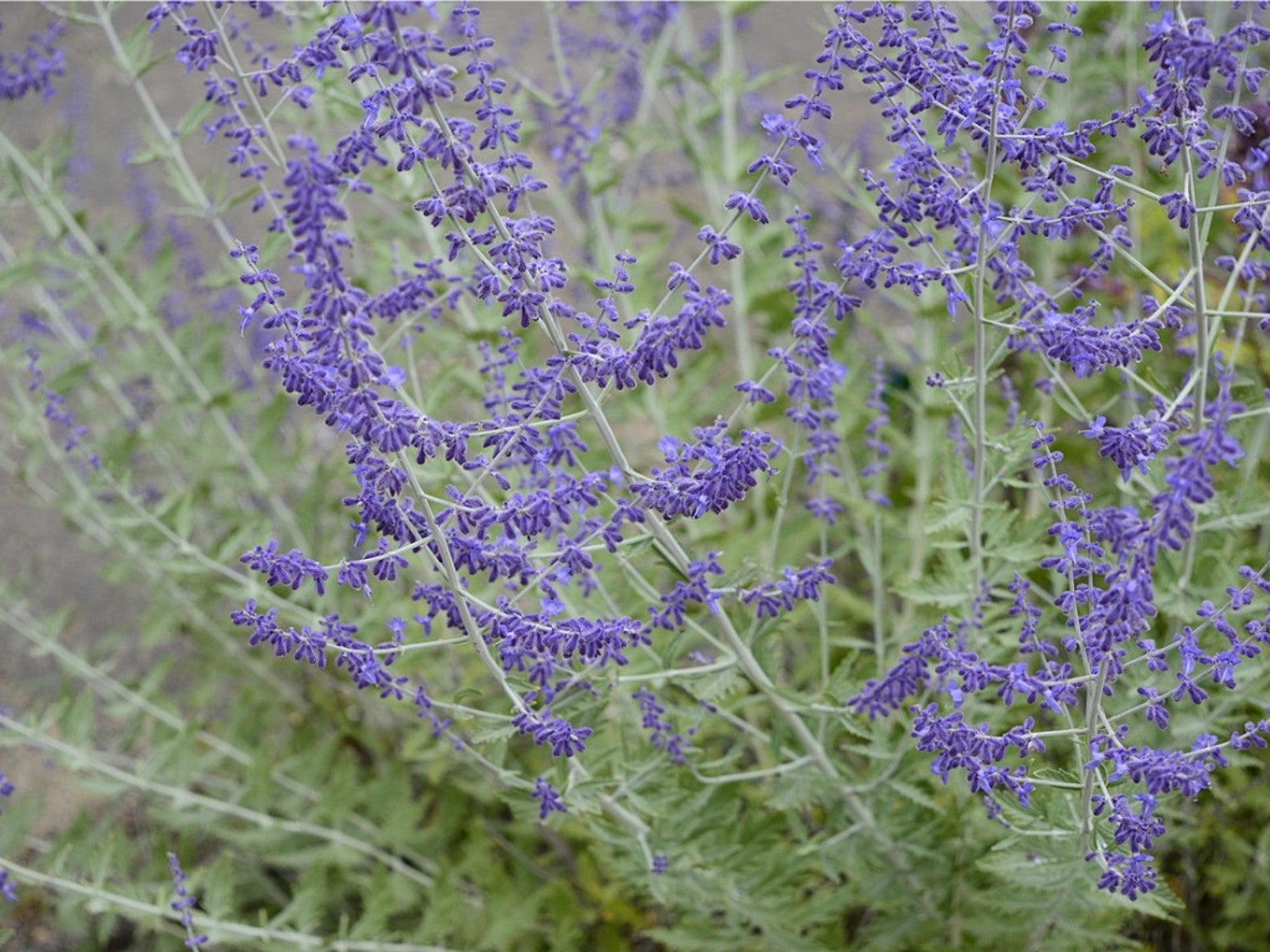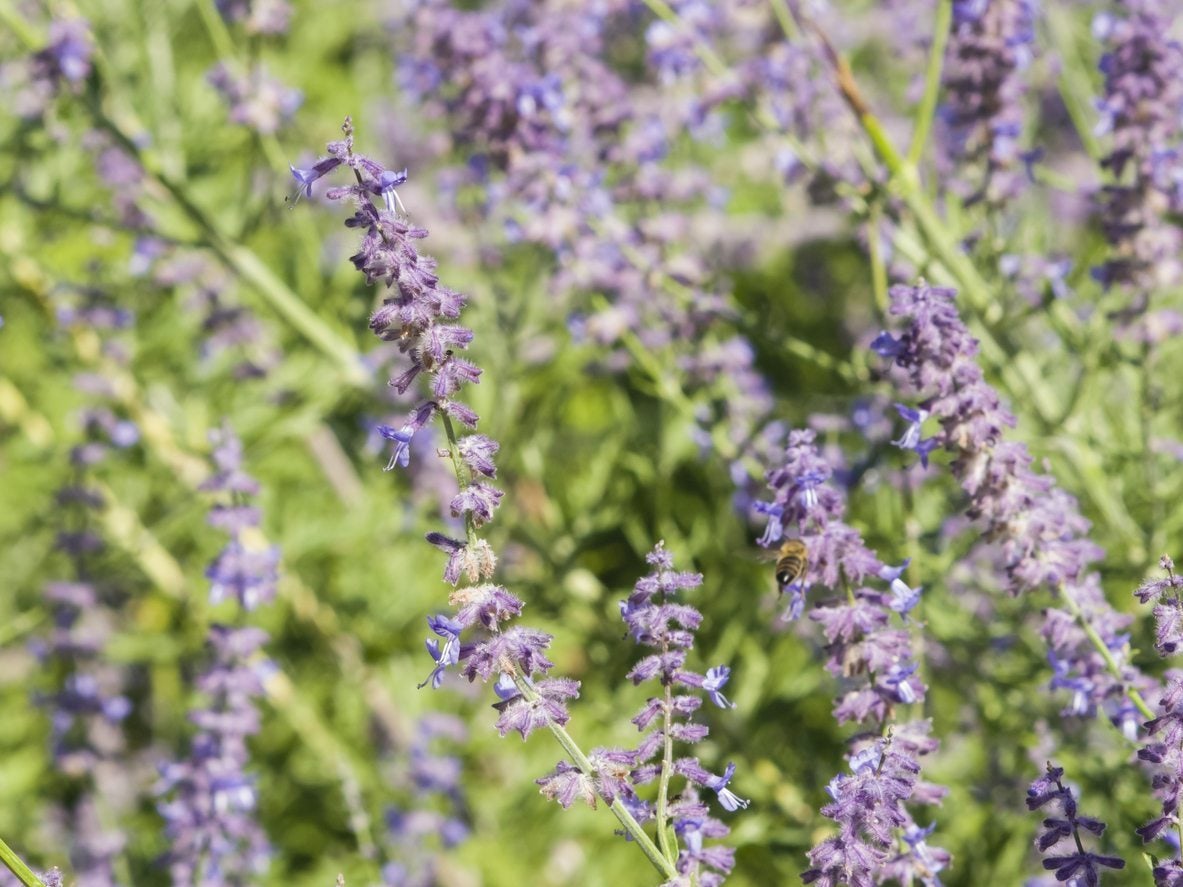Tips For Growing Russian Sage


Mary Ellen Ellis
Quick Russian Sage Facts:
- Botanical name - Salvia yangii (formerly Perovskia atriplicifolia)
- Height - 3 to 5 feet (0.9 to 1.5 m)
- Spread - 2 to 4 feet (0.6 to 1.2 m)
- Sun exposure - Full sun
- Soil requirements - Well-drained to dry
- Hardiness zones - 5 to 9
- When to plant - Spring
Admired for its silvery gray, fragrant foliage as much as its lavender-purple flowers, Russian sage (Salvia yangii, formerly Perovskia atriplicifolia) makes a bold statement in the garden. The abundant, spiky clusters of flowers bloom from late spring until autumn, almost completely obscuring the feathery, sage-scented leaves. It prefers arid conditions, making it an ideal plant for xeriscaping.
How to Grow Russian Sage
Russian sage is hardy in USDA plant hardiness zones 5 through 10. Grow Russian sage in perennial beds in areas that tend to stay dry and have full sun coverage. Growing Russian sage in partly shaded locations may cause the plants to sprawl. Situate the plants in masses, along borders, or near patios to enjoy summer-long flowers and a fresh scent.
Set out new plants in early spring, spacing them 2 to 3 feet (0.6-0.9 m) apart. Water the plants occasionally during dry spells until they are established and growing. If you want to apply mulch around the plants, gravel is better than organic mulch because it allows better moisture evaporation.
When to Plant Russian Sage
Planting Russian sage in late spring is best. Time planting so the soil is warm, but the weather isn’t too hot and dry yet. Planting during this period will give your plants time to establish before harsher summer conditions begin. Plant them in the ground to the same depth they had in the nursery or garden center container.
Light & Water Requirements
Russian sage does best in full sun. If grown in partial shade, the stems are more likely to flop over, requiring support from stakes. They will also produce fewer flowers without full sun conditions.
Water new plants regularly during the first season to help them establish a healthy root system, but let the soil dry out in between. Once established, Russian sage requires little water and will be very drought-tolerant.
Soil & Fertilizer Needs
The soil should drain very well, as Russian sage will not tolerate soil that remains consistently moist or soggy. Amend the soil with compost or vermiculite if it is too heavy and doesn’t drain adequately. It does not need rich or fertile soil and will be fine in medium to poor soil. Scatter a handful of general-purpose fertilizer or a shovelful of compost around each plant every other year in spring before new growth emerges. North of USDA Zone 6, provide a 2-inch (5 cm) layer of pine needles over winter and remove them in spring.
Gardening tips, videos, info and more delivered right to your inbox!
Sign up for the Gardening Know How newsletter today and receive a free copy of our e-book "How to Grow Delicious Tomatoes".
Pruning Russian Sage
Pruning Russian sage can help you manage the size and encourage bushier growth, but winter pruning is optional. While allowing the stems and seed pods to remain in the garden until spring creates winter interest, if you prefer a tidier appearance, you can cut the stems back to 8 to 12 inches (20 - 30 cm) above the ground.
Spring and summer care for Russian sage consists mainly of pruning. When new spring growth emerges, cut the old stems back to just above the lowest set of leaves. If the plant begins to spread open or sprawl in late spring or summer, shear off the top one-third of the stems to encourage upright growth. Remove the top half of the stems if the plant stops blooming in summer; it will promote new growth and a fresh flush of flowers.
Propagating Russian Sage
You can grow Russian sage from seed or propagate existing plants by basal cuttings, which is the preferred method. Take a cutting when you see new growth after pruning in early spring. Cut off some of the new growth along with part of the roots and runners.
Plant the cutting from your Russian sage in a container with a very light soil mix. Keep the soil moist and wait for additional growth to appear. Then it’s ready to go to its new place in the garden.
You can also propagate Russian sage by dividing the clumps, but this is more work. However, dividing the clumps every four to six years reinvigorates the plants and helps to control their spread.
Problems, Pests & Diseases
The most common issue with Russian sage is root rot from soggy soil. The soil must drain well for it to thrive. Avoid overwatering. Pests are rarely a problem as the aroma repels most insects.
One issue with Russian sage tends to occur in late summer as the stems flop over and need support. If you plant a few together in masses, they hold each other up to some extent. You can also use stakes as needed.
Russian Sage Varieties
There isn’t a lot of variation between cultivars, but you can find some differences in size, foliage, and flower color:
- ‘Blue Spire’ has deeply cut leaves and purple flowers and grows tall.
- ‘Little Spire’ is a smaller variety, rising only to about two feet (0.6 m). It has lavender-blue flowers.
- ‘Longin’ has a more upright growth habit than some other varieties. The stiff stems help them stay upright and give the plant a more formal appearance.
- ‘Blue Haze’ has paler blue flowers and less finely cut leaves than other types.
- ‘Filigran’ comes from Germany. It has very lacy leaves and brighter blue flowers.
Caring for Russian sage is easy once this tough plant is established in garden beds. Yearly pruning is generally all the maintenance needed to enjoy delicate, purple flowers and lacy, aromatic foliage all summer.

Jackie Carroll has written over 500 articles for Gardening Know How on a wide range of topics.
- Mary Ellen EllisWriter
-
 Looking For Plants To Give You The Soft And Fuzzies? Try These 5 Fuzzy Leaf Plant Options
Looking For Plants To Give You The Soft And Fuzzies? Try These 5 Fuzzy Leaf Plant OptionsLovers of texture, drama, silver foliage and tactile plants will adore these special sensory garden additions. These fuzzy leaf plant options will leave you all aglow
By Susan Albert
-
 Get Ready For A Summer Of Hummers! Grow These Full Sun Hummingbird Plants and Flowers
Get Ready For A Summer Of Hummers! Grow These Full Sun Hummingbird Plants and FlowersIf you’re lucky enough to enjoy a sunny backyard, make sure you are maxing out on your pollinator opportunities and grow these full sun hummingbird plants and flowers
By Tonya Barnett
